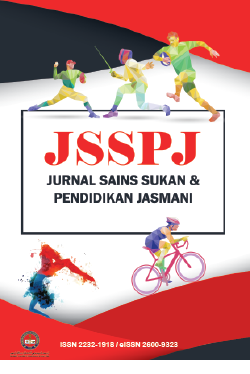Validity And Reliability of The Questionnaire Instrument Relationship Between Behavior and Environment on Body Fat Percentage Among 10 and 11 Year old Female Students
Kesahan dan Kebolehpercayaan Item Instrumen Soal Selidik Hubungan Tingkah Laku dan Persekitaran ke atas Peratus Lemak Tubuh dalam Kalangan Murid Perempuan 10 dan 11 tahun
DOI:
https://doi.org/10.37134/jsspj.vol10.2.4.2021Keywords:
body fat percentage, behaviour, environmentAbstract
This research was conducted to obtain the validity and reliability of the questionnaire instrument relationship between behavior and environment on body fat percentage among 10 and 11 year old female students. This research involved 132 female students in Hulu Langat district, Selangor. 48 questionnaire items that represented six constructs that are sedentary behaviour, nutritional behaviour, media environment, family environment and school environment. Factor analysis showed only 45 items that represented those six constructs can be accepted. Meanwhile, Alpha Cronbach value showed reliability coefficient value for both behaviour and environment is α = .68. Due to that, findings of this study showed this questionnaire is valid and reliable to be used among primary school’ female students.
Downloads
References
Anasuri, S. (2016). Mass media making its impact on overweight and obesity: a developmental overview. IOSR Journal of Humanities and Social Sciences, 21(4), 29-39.
Ariffin, S. R., & Ahmad, J. (2010). Pembangunan instrumen kemahiran generik pelajar berasaskan penilaian pensyarah dengan menggunakan model pengukuran rasch pelbagai faset. Jurnal Pendidikan Malaysia, 35(2), 43-50.
Black, W., & Babin, B. J. (2019). Multivariate data analysis: Its approach, evolution, and impact. In The Great Facilitator (pp. 121-130). Springer, Cham.
Bandalos, D. L., & Finney, S. J. (2018). Factor analysis: Exploratory and confirmatory. In The reviewer’s guide to quantitative methods in the social sciences (pp. 98-122). Routledge.
Chan, L. L., & Idris, N. (2017). Validity and reliability of the instrument using exploratory factor analysis and Cronbach’s alpha. International Journal of Academic Research in Business and Social Sciences, 7(10), 400-410.
Daud, S. H. S., & bt Yusof, H. (2017). Kesahan Dan Kebolehpercayaan Instrumen Kajian Penyeliaan Berkesan. JuKu: Jurnal Kurikulum & Pengajaran Asia Pasifik, 5(3), 50-61.
DeMonbrun, M., Finelli, C. J., Prince, M., Borrego, M., Shekhar, P., Henderson, C., & Waters, C. (2017). Creating an instrument to measure student response to instructional practices. Journal of Engineering Education, 106(2), 273-298.
DeVellis, R. F. (2017). Scale Development: Theory and Applications (4th ed.). Thousand Oaks, CA: Sage. [Paper reference 48]
Esgin, T., Hersh, D., Rowley, K., Gilroy, J., & Newton, R. U. (2019). Indigenous research methodologies: Decolonizing the Australian sports sciences. Health Promotion International, 34(6), 1231-1240.
Garrido-Miguel, M., Oliveira, A., Cavero-Redondo, I., Álvarez-Bueno, C., Pozuelo-Carrascosa, D. P., Soriano-Cano, A., & Martínez-Vizcaíno, V. (2019). Prevalence of overweight and obesity among European preschool children: a systematic review and meta-regression by food group consumption. Nutrients, 11(7), 1698.
Johnson, J. A., & Johnson, A. M. (2015). Urban-rural differences in childhood and adolescent obesity in the United States: A systematic review and meta-analysis. Childhood Obesity, 11(3), 233–241.
Menekli, T., Yildirim, Y., & Fadiloğlu, Ç. (2018). An Examination of the validity and reliability of the turkish version of the nurses’ attitudes toward obesity and obese patients (Natoops) scale. COJ Nurs Healthc, 3, 258-264.
Mostafavi, S. A., Akhondzadeh, S., Mohammadi, M. R., Eshraghian, M. R., Hosseini, S., Chamari, M., & Keshavarz, S. A. (2017). The reliability and validity of the persian version of three-factor eating questionnaire-R18 (TFEQ-R18) in overweight and obese females. Iranian Journal of Psychiatry, 12(2), 100.
Ochoa, A., & Berge, J. M. (2017). Home Environmental Influences on Childhood Obesity in the Latino Population: A Decade Review of Literature. Journal of Immigrant and Minority Health, 19(2), 430–447.
Pallant J. (2011). Multiple regression. SPSS Survival Manual. Crows Nest, NSW, Australia: Allen & Unwin; 2011. p. 148-67.
Sen, S., & Cohen, A. S. (2020). Sample Size Requirements for Applying Diagnostic Classification Models. Frontiers in Psychology, 11, 4050.
Schönbrodt, F. D., & Wagenmakers, E. J. (2018). Bayes factor design analysis: Planning for compelling evidence. Psychonomic bulletin & review, 25(1), 128-142.
Sheldrick, M. P. R., Tyler, R., Mackintosh, K. A., & Stratton, G. (2018). Relationship between sedentary time, physical activity and multiple lifestyle factors in children. Journal of Functional Morphology and Kinesiology, 3(1).
Swinburn, B., & Vandevijvere, S. (2016). WHO report on ending childhood obesity echoes earlier recommendations. Public Health Nutrition, 19(1), 1-2.
Tabachnick, B. G., & Fidell, L. S. (2007). Using Multivariate Statistics (5th ed.). Boston, MA: Allyn & Bacon.
Vijayalakshmi, N. (2019). Behavior Modification Techniques-An Awareness Study. Shanlax International Journal of Education, 7(2), 20-24.
Zarizi, A.R. (2018). Kesahan item dalam gagasan dan kebolehpercayaan instrumen soal selidik peramal faktor obesiti. Jurnal Penyelidikan Tempawan, 35(March), 19–36.





